6 In-House Development Examples for 2025
Internal IT teams have never faced greater demand for custom solutions. This is well documented. However, there’s a lot of misunderstanding about the kinds of tools they actually build. Today, we’re putting this right with our roundup of in-house development examples.
Of course, every business faces its own unique challenges.
As such, we need to be conscious of the underlying issues that feed this ever-growing demand. That way, we can begin to understand not just the kinds of tools that internal devs build, but also the strategies that modern teams can use to output better solutions, for less.
That’s the true value of learning by example.
In this article, we’re looking closely at some of the most illustrative in-house software development examples, to help you make the most of your internal team’s resources.
But first, let’s take a quick step back.
What is in-house development?
In-house development means building solutions with your existing internal resources. So, you might have a dedicated team of coders. Alternatively, you might use app-builder tools to enable non-developers to build solutions themselves.
In either case, the ultimate goal is to use technology to alleviate or overcome specific business problems and pain points - most often, boosting efficiency and productivity within various processes and workflows.
Often, this means creating bespoke applications. But in-house development also involves configuring and customizing existing solutions, as well as providing support, maintenance, and other related functions.
We’ll look at some in-house software examples that commonly crop up in a second. For the minute it’s also worth noting that in-house development is also characterized by the fact that most tools are built for internal use - rather than by an outsourced development company.
Additionally, in-house developments are characteristically built around relatively discrete use cases. These are often highly specific or even totally unique to the business in question.
Why do businesses build tools internally?
Before we dive deeper into more specific use cases and in-house development examples, it’s useful to turn our attention to the why behind it all.
The best way to get our heads around this is to consider the alternatives.
So, let’s say you’ve identified a need for a particular kind of platform. We don’t need to worry about the specifics of this just yet.
Essentially, you’ve got three broad types of procurement strategies that you can leverage:
- Buying a tool off the shelf.
- Contracting the project out.
- Developing a solution yourself.
There are variations within each of these categories too, but for our purposes, we only need to be aware of the broad options.
So why would you build a solution yourself instead of paying someone else to do it or using something that’s already on the market?
Well, lots of reasons actually.
Let’s just think about the most obvious ones for now.
We could rule out using a pre-made solution straight off the bat if we had very specific needs, to the point that no suitable product exists. Take a look at our guide to deciding when to build vs buy software for a fuller discussion.
Figuring out if it’s best to build something yourself or pay someone else to do it is a trickier prospect.
In truth, there are a wide number of competing concerns at play here. As such, a thorough analysis is needed. Check out our guide to in-house vs outsourcing software development for more information.
For now, a good example of when you’d go in-house could be any project that requires a large degree of commercial awareness from our in-house development talent pool.
How do in-house teams build tools?
Unfortunately, there are probably as many answers to this question as there are businesses - or businesses with full-time in-house teams and development services anyway.
In fact, we’ll see huge variances across different businesses in terms of both the tools and methodologies employed for internal projects.
So where does this leave us?
It’s arguably more useful to consider the challenges facing internal developers. That way, we’re in a better position to think about the kinds of tools and strategies that will help us make the most of our development capacity, rather than worrying about what other companies do.
This feeds many of the pros and cons of in-house development vs outsourcing development processes.
The big thing here is that teams are seeing an explosion in demand for custom tools, at a time when budgets are being squeezed by harsh economic factors. Then there’s the high costs of both hiring processes and contracting to outsourcing partners.

Despite this, contracting to an outsourcing company might not be viable - so we need to develop software internally one way or another.
To reflect this reality, IT teams can draw on a couple of key strategies.
Some companies choose to alleviate burdens on specialist developers by democratizing the way solutions are built. This means empowering non-developers to create tools for their own teams, through citizen development initiatives.
Alternatively, we can go down the route of empowering our development team to do more with less.
The only way to do this is if they can build solutions faster.
Because of this, more and more businesses are turning to low-code development to speed up turnaround times, thereby cutting down on the labor costs of building solutions. For instance, we can eliminate the need for outsourcing teams when we empower non-technical colleagues like project managers or database administrators to build solutions.
We’ll see how Budibase is transforming the way businesses build solutions for a wide range of business problems a little bit later.
Take a look at our guide to legacy app modernization .
What kinds of solutions do internal teams build?
Before we move on to our specific in-house development examples, it’s going to be productive to reflect on some of the general characteristics that these share. In other words, what kinds of solutions are normally built by internal teams?
We’ve hinted at a couple of the key points already.
One is that they’re normally focused on building solutions for highly business-specific problems.
To flesh this out a bit, in-house developed software normally brings along some combination of the following:
- A need to draw on esoteric data sources or legacy tools.
- Highly unique or granular workflows that need to be digitalized.
- Restrictive non-functional requirements that rule out off-the-shelf tools.
- Additional legal, financial, or operational constraints.
We can also point to important trends in the scope of your typical internal build.
The vast majority of the time, we’re not talking about all singing, all dancing, revolutionary solutions. Rather, as we’ll see with our in-house development examples, internal devs are largely tasked with producing a large number of relatively simple tools, at speed.
Take a look at our ultimate guide to in-house software development to find out more.
6 in-house development examples
With a clear picture of the peculiarities of internal builds, we can move on to our in-house development examples.
At this point, it’s worth circling back to our goal with this article. That is, to illustrate the key points that determine how, when, and why companies choose in-house development, along with what this says about best practices.
Let’s take a look.
1. Custom GUIs for esoteric data
GUI stands for graphical user interface. This is actually a generic term for any interface that uses visual elements to allow users to carry out different actions, but nowadays we mostly use it in reference to database GUIs.
So, GUIs that are specifically built to interact with a particular data source.
The goal is to create a faster, easier way to carry out specific actions, instead of relying on CLI tools.
Off-the-shelf solutions exist for most data sources, but internal builds are often more effective because they can be more closely tied to your unique requirements relating to a specific data set.
Typically, this is some combination of the following:
- Writing, testing, and storing queries and procedures.
- Triggering stored queries and procedures.
- Visualizations.
- Data management and manipulation actions.
You might also like our guide to data access control .
Our example is a simple SQL GUI.
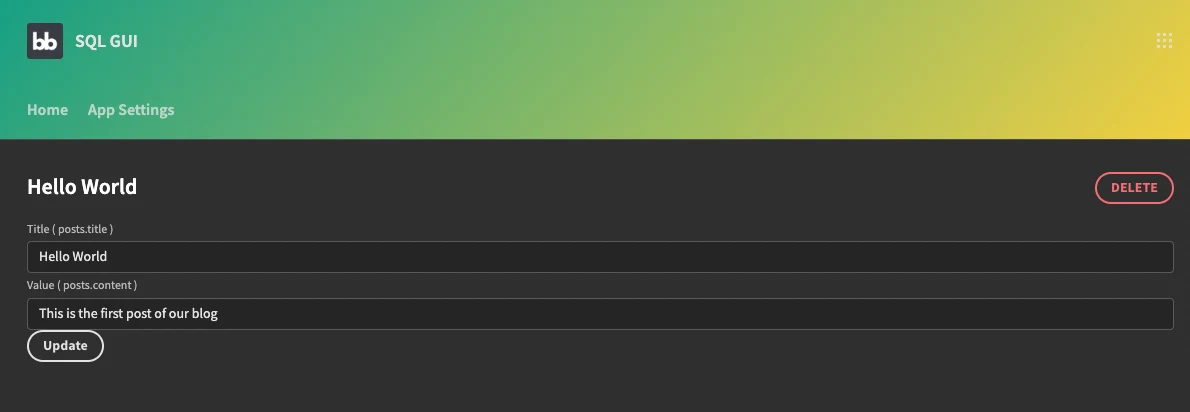
With it, we can perform two sets of tasks:
- Adding, editing, deleting, and viewing individual rows.
- Testing, saving, and calling custom queries.
The idea is that we can save our developers and on-the-ground users huge amounts of time by providing simple form-based interfaces to carry out defined actions, without using a CLI.
Check out our in-depth guide to building a database GUI for more information.
2. CRUD apps and data management
In a similar vein, we have CRUD apps. Like GUIs, these are used to provide a simple interface for interacting with and managing datasets. However, the actions available to users are more specific and limited.
CRUD tools are used to create, read, update, and delete database entries. Hence the name.
These are the basic operations that we can perform on any set of data. When we consider the alternative - manually performing queries in a GUI tool or with a command line interface - it’s quite obvious what a dedicated CRUD tool brings to the table.
That is, boosting efficiency by allowing users to perform common data management tasks, without needing to write queries manually. We simply can’t expect our users to be au fait with all of the different DBMS tools that we use.
This is useful in just about any kind of business process you can imagine.
For our in-house development example, we have a simple IT incident report tool:
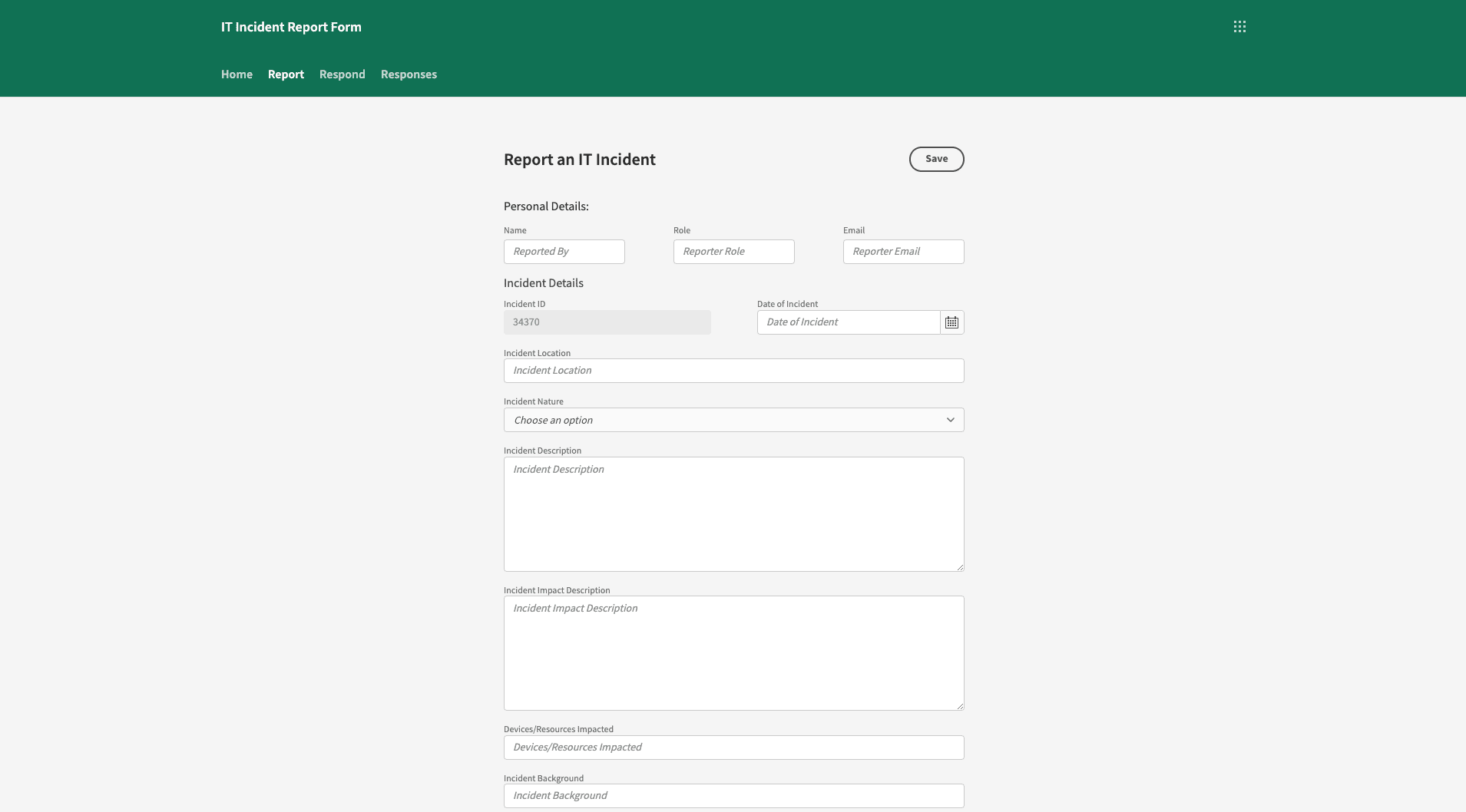
Users can:
- Create entries to log an incident.
- Read entries to assess the details.
- Update the details with response details.
- Delete entries if the record is no longer needed.
This achieves a couple of important goals.
First, we can empower non-technical users with a simple, intuitive tool for logging issues. Second, we create a robust, systematic approach to responding to incidents. Third, we improve oversight and record-keeping relating to incidents and responses.
All the while, we’re improving efficiency and cutting response times.
Check out our IT incident report form template to see how this example in action.
3. Digitalizing approval workflows
Some of the best in-house development examples are focused on codifying workflows around requests and approvals. These can relate to specific resources, actions, projects, or really anything else where there’s a need to follow set processes to authorize various requests.
This becomes more and more important the larger your team gets.
For example, authorizing vacation requests is pretty straightforward if you have a skeleton team with only a few colleagues. Once your employee count creeps up, it becomes much more challenging to ensure everyone gets their fair allocation, and still maintain continuity.
So, we’d need to implement consistent rules, rather than relying on individual line managers’ judgment.
We can apply the same logic to all sorts of request and approval workflows. For instance, in a small team, it’s easy for your IT team to manage requests for different assets and devices, using manual communications. This won’t be viable with hundreds of employees though.
The same applies to invoice submissions, project initiations, maintenance requests, and more.
Our in-house development example is a simple vacation request tool:
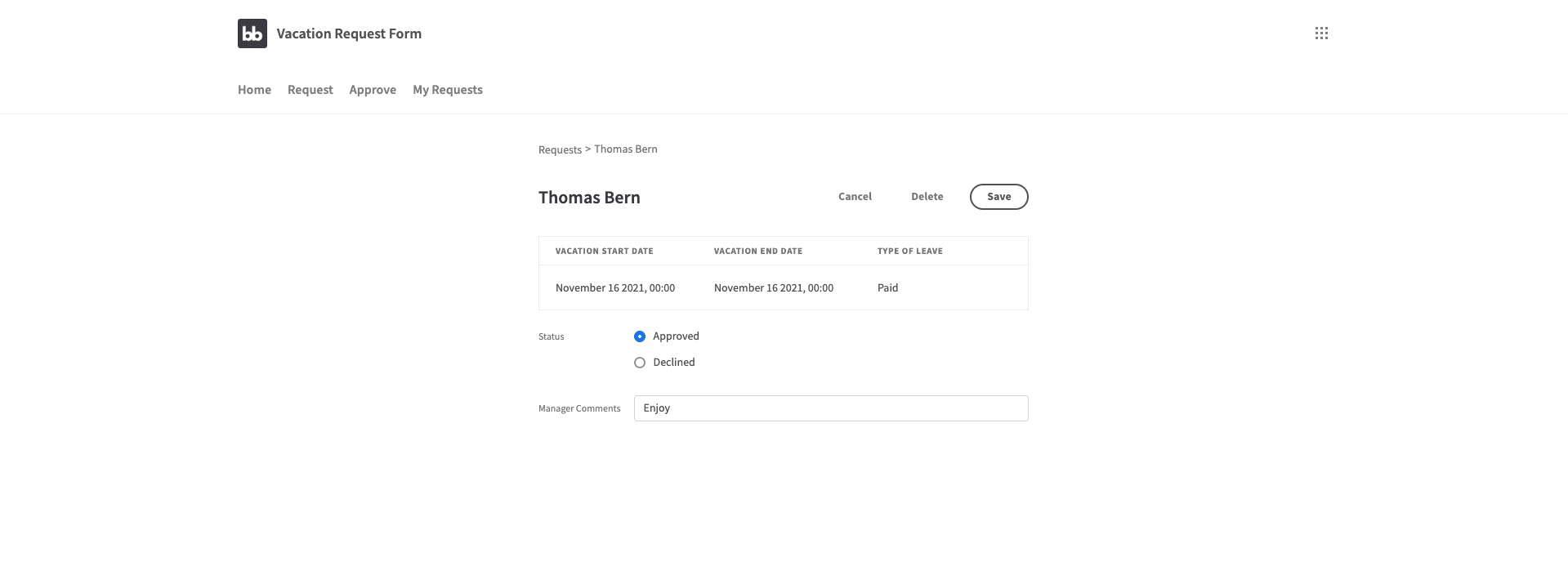
On the one hand, employees can request time off. Their line manager can then manually review, approve, or decline this request.
On the other, you can automate business logic to reduce the need for manual admin work. For example, by defining rules to automatically decline requests based on the individual employee’s remaining leave, upcoming project events, or the wider team’s resourcing needs.
Take a look at our vacation request form template to learn more.
4. Dynamic goal reporting
Some of the most common examples of in-house developments are actually much simpler than the tools we’ve seen so far. In fact, we can point to several mission-critical internal builds that require almost no end-user interactivity.
Instead, many tools, like dashboards, simply provide fast, effective access to key insights.
Often, this means providing decision-makers with real-time reporting tools, relating to defined business goals. This might be at an organizational level or within individual teams and departments.
From a technical perspective, this can present more challenges than you might initially expect. One is that we need to draw on, process, aggregate, and display several data sets, often with different formatting conventions - in real-time.
The goal here is to create a reliable single source of truth.
Another is that we need to ensure fast, easy access for the right people while preventing unauthorized access - since our high-level business data can often be sensitive or even confidential.
For our in-house development example, we’ve got a simple OKR tracker:
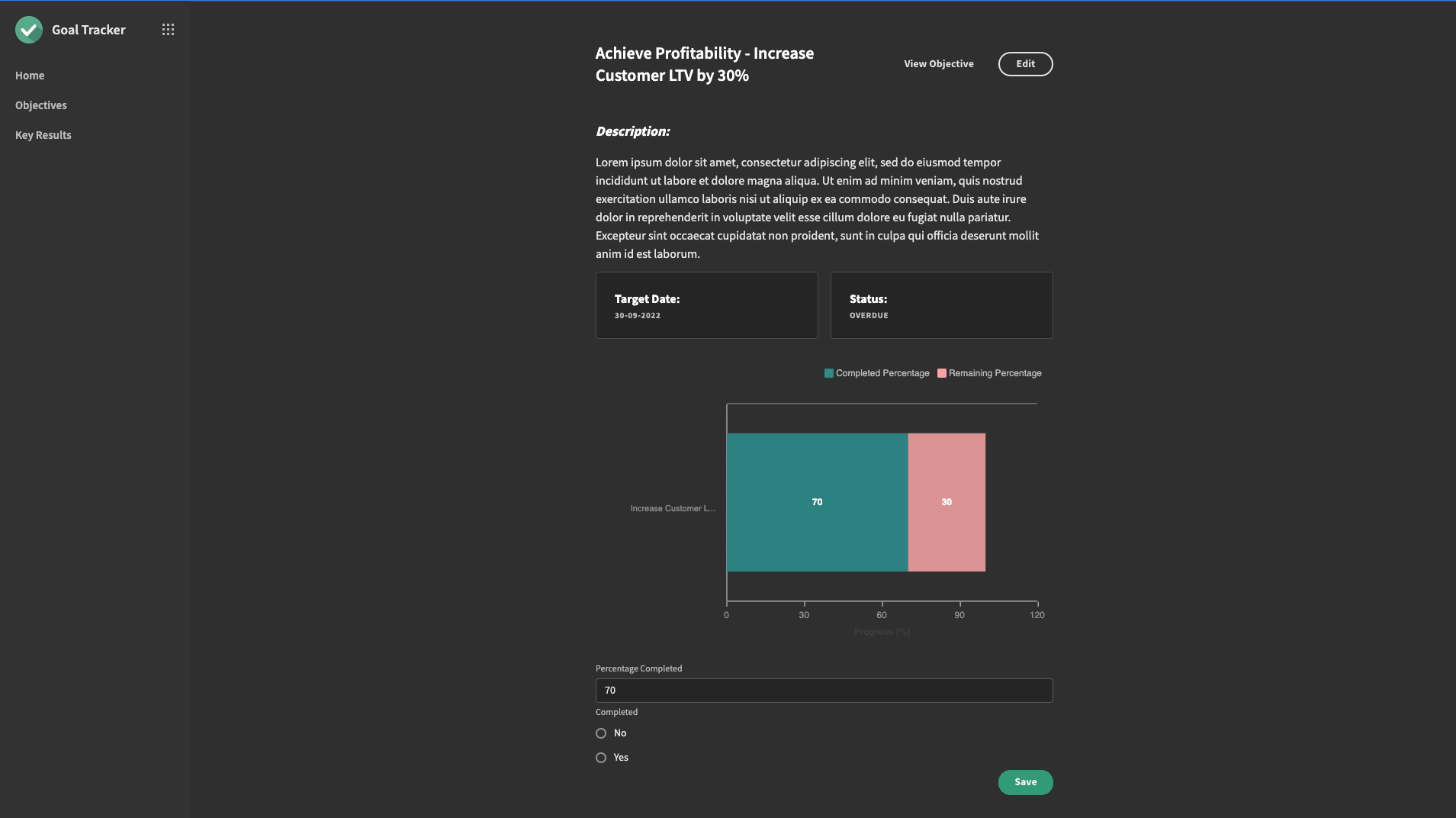
The core functionality here is allowing users to track progress across defined business goals.
We have a couple of options here in terms of how we populate data. So, we can draw on existing tools or we can allow users to manually input project updates.
In either case, the idea is to create a single interface for decision-makers to review progress across wider business goals, as well as their constituent, granular objectives.
Take a look at our OKR goal template to learn more.
5. Self-service admin tools
It should come as no surprise that administrative workflows can easily turn into massive money pits. The principle behind self-service admin tools is that we can alleviate this financial pressure, by allowing users to take specific actions themselves, whenever they need to.
The trouble is, that administrative processes are often highly unique to individual organizations.
So, custom solutions are often needed.
There is a wide range of use cases for these kinds of tools, but the easiest to get our heads around mainly relate to human resources, operations, and customer-facing workflows.
The most basic function of self-service admin tools is to ensure we can keep relevant information up to date without overburdening our administrators.
Let’s see how this would work in a basic in-house development example.
Chances are, you use a whole suite of internal programs that require up-to-date personal, professional, and contact information for each of your employees. For instance, payroll, HR, directory, or training and development platforms.
We need this data to be current, correct, and consistent. Otherwise, we’ll encounter problems with basic tasks. For instance, processing payments or contacting the right person in an emergency.
However, we also need to grapple with the fact that your employees have better things to do than tell HR that they’ve got a new cell phone contract. Even if they do so, we don’t want to create unnecessary admin work.
We can solve both problems with our fifth in-house development example - a single form to update employee details across multiple external platforms:
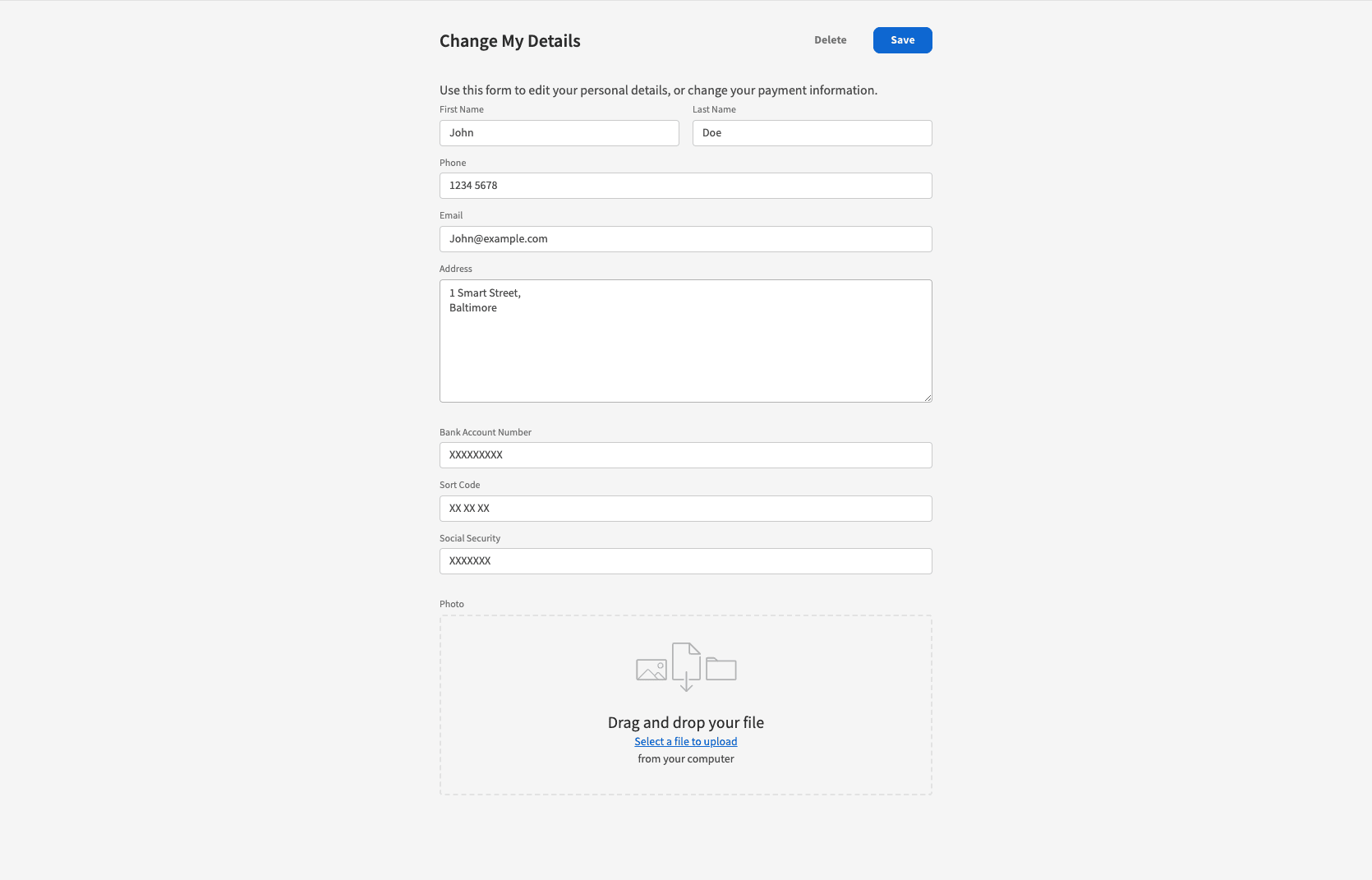
This one is pretty self-explanatory. With Budibase’s market-leading form builder tools, external data support, and custom automations, it’s never been easier to create solutions for managing employee information.
Check out our employee portal app template to see how you can implement this.
6. Directories and knowledge management
Finally, we have in-house development examples that ensure that our team has access to the information they need, right at their fingertips. For the most part, we can talk about two distinct categories of information here.
The first is organizational information. That is, anything relating to our history, mission, ethos, employees, company structure, core market, offices, and other general aspects of who you are and what you do.
The second is more process-specific information. This relates more to how your employees carry out their daily work. For example, sales playbooks or knowledge management tools for your IT team.
The goal with this second category is, in part, to ensure continuity and consistency across individual members of our team, by providing an accessible repository of information to refer to.
For our in-house development example, we’ve chosen a simple employee directory:
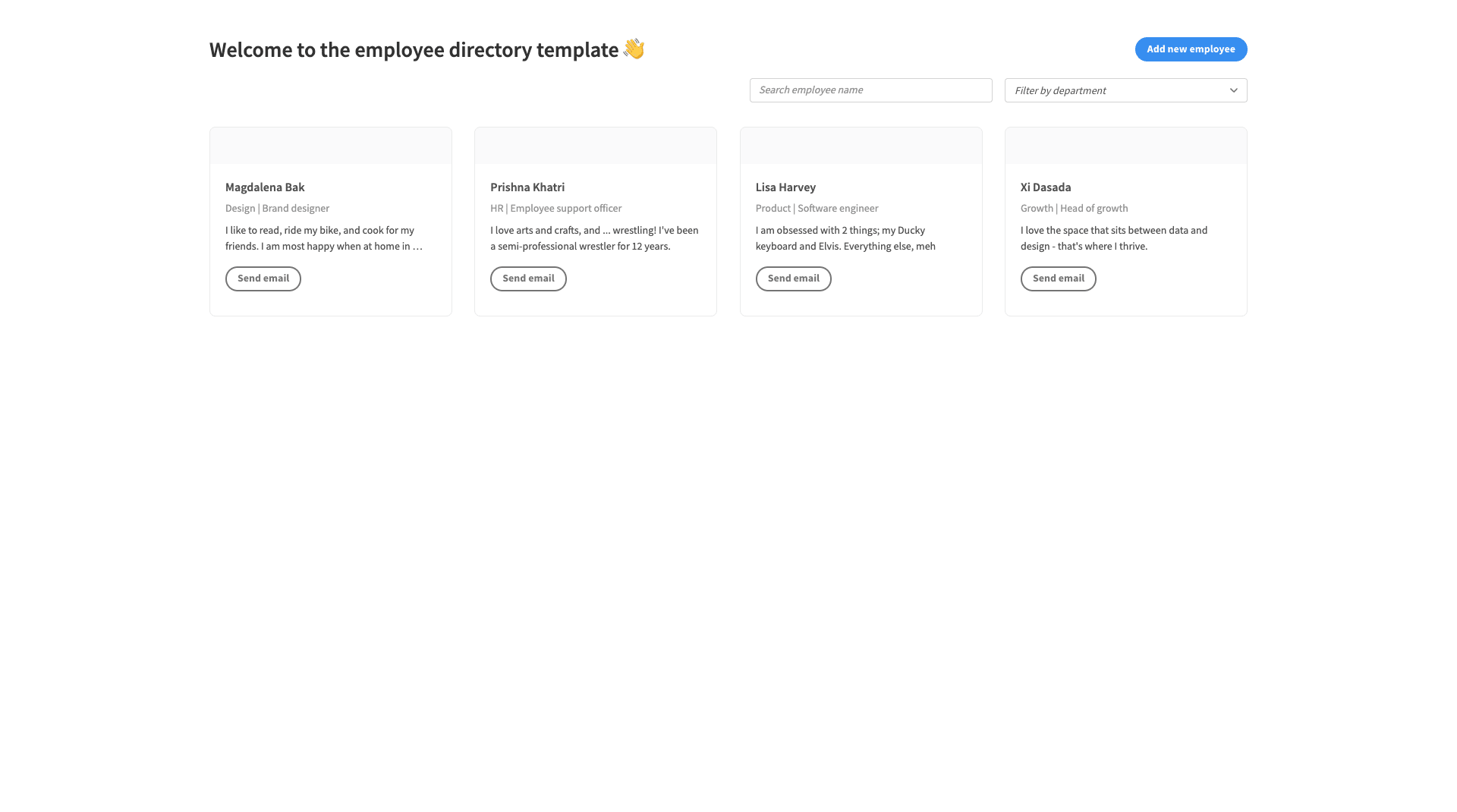
This is an undersung yet indispensable tool for any modern organization - especially in the context of remote, international workforces.
Consider the fact that your employees might never have even met in real life. So, for many queries, they’re unlikely to know who the best person to speak to is, let alone how to reach them. Then there are issues like language barriers.
This is an extreme example of where directory tools can offer huge benefits across your organization.
Check out our employee directory template to find out more about implementing a custom solution.
Budibase for in-house developers
Budibase is changing the way businesses build internal tools, forever.
Across all of our in-house development examples, the challenge is not so much building any specific solution, as it is doing so in the context of ballooning demand for custom tools and a growing shortage of talented engineers.
In-house developers have the skills and knowledge they need. There just aren’t enough hours in the day.
Luckily, Budibase makes it faster and easier than ever to output professional solutions. Let’s see how.
Simplicity by default
Our ethos is simplicity by default, and extensibility when you need it. No other low-code platform can match Budibase for expediency, intuitiveness, or customization. Connect your data, build interfaces, craft automation rules, and deploy working solutions, in a fraction of the time.
To find out more about what makes Budibase tick, check out our features page .
Autogenerated interfaces
Don’t waste your developers’ time with repetitive, menial builds. With Budibase’s autogenerated screens, you can create fully functional CRUD apps for a huge range of data sets, with just a couple of clicks.
Say goodbye to waiting months for your team to get around to building simple solutions. Budibase is designed to free developers up to work on the tasks where their skills are needed the most.
Extensive data support
Budibase leads the pack for external data support. With built-in connectors for SQL, Postgres, Airtable, Mongo, Oracle, Couch, S3, REST, and more, our low-code platform is the perfect solution for leveraging all kinds of existing data in app builds.
We also offer our own built-in database, BudibaseDB. Use a wide range of data types, formula variables, and relationships to quickly build your app’s data layer from scratch.
Flexible hosting
Budibase is the smart choice for security-conscious businesses that want to take advantage of low-code development. We offer self-hosted licenses, with deployment options including Kubernetes, Digital Ocean, Docker, and more.
Alternatively, you can use Budibase Cloud and let us worry about hosting your solutions. Check out our pricing page for more details on both options.
Custom plug-ins
Budibase stands apart from any other low-code platform for extensibility. We’ve launched custom plug-ins to empower our users to build their own components and data sources, to use across their Budibase solutions.
Check out our plug-ins documentation to find out more.
Role-based access control
Use Budibase’s built-in role-based access control to streamline user management, without compromising on security or usability. Grant user permissions at a database, query, screen, or component-level, with ease.
Check out our in-depth guide to implementing RBAC to learn more.
Step-based automations
Budibase is the perfect solution for businesses that need to build automated workflows, fast. We offer an intuitive, flow-chart-based interface for combining, nesting, and configuring a range of built-in automation actions, along with defining triggers.
Check out our in-depth guide to workflow automation for more details.
50+ free app templates
In case you didn’t realize, all of our in-house development examples were built in Budibase. However, our platform is capable of so much more than this.
To prove it, we’ve created 50+ free, customizable, and fully functional app templates .
To get started building applications the fast, cost-effective way, sign up to Budibase today.